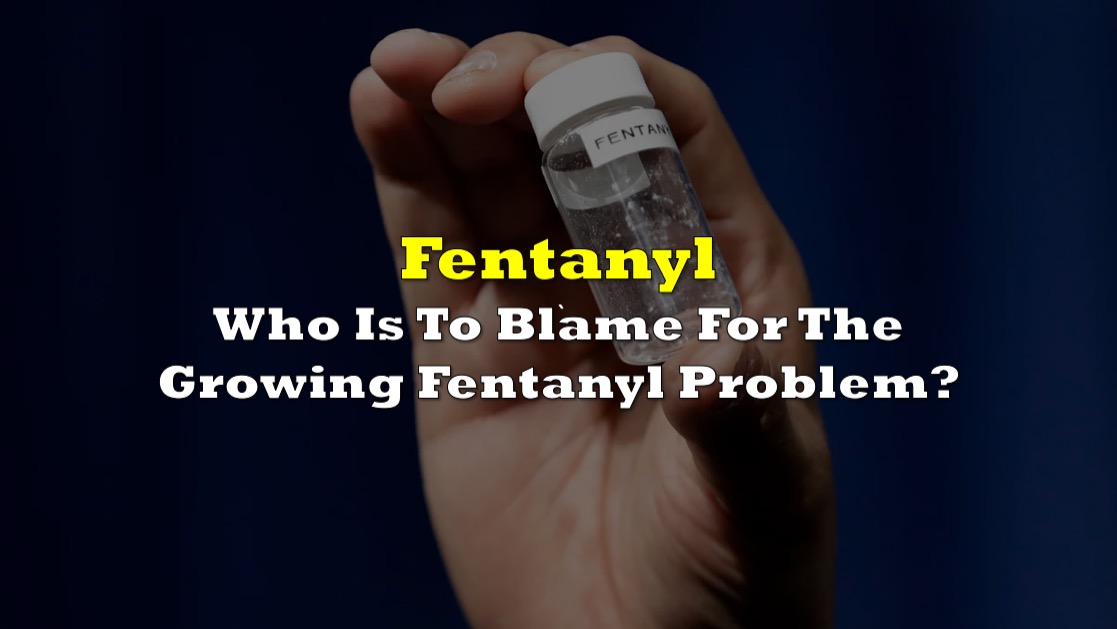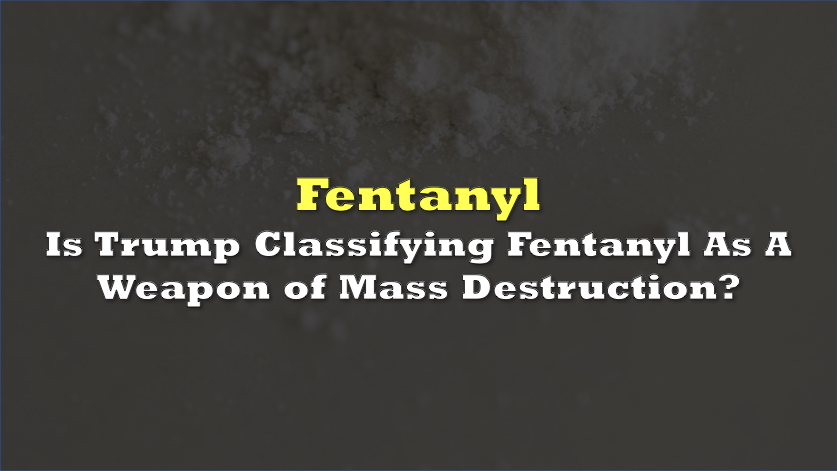FULL DISCLOSURE: This content is sponsored by PharmaDrug Inc.
The United States is grappling with a relentless surge in fentanyl-related overdose deaths, marking a grim chapter in the ongoing battle against opioid addiction. As the fourth wave of the opioid epidemic crashes through communities nationwide, the devastating toll of fentanyl misuse has left families shattered and communities reeling.
Kim Blake’s heartbreaking loss serves as a poignant reminder of the human tragedy behind the statistics. Six years ago, her son Sean tragically succumbed to an accidental fentanyl overdose in Burlington, Vermont, at the age of 27. Reflecting on her profound grief, Ms. Blake shared, “Every time I hear of a loss to substance use, my heart breaks a little more.” Her sentiments echo the anguish felt by countless families who have lost loved ones to this epidemic of addiction.
In 2021, the United States reached a somber milestone as drug overdoses claimed the lives of over 100,000 individuals in a single year. Shockingly, more than two-thirds of these deaths were linked to fentanyl, a synthetic opioid renowned for its potency, being 50 times stronger than heroin.

A recent study conducted by researchers at the University of California, Los Angeles (UCLA), sheds light on the alarming trajectory of fentanyl-related fatalities. Analyzing data spanning from 2010 to 2021, the study underscores how fentanyl has reshaped the landscape of drug overdoses in America over the past decade. Lead author of the study, Chelsea Shover, emphasized, “The rise of illicitly manufactured fentanyl has ushered in an overdose crisis of unprecedented magnitude.”
Of particular concern is the emergence of a disturbing trend involving the co-use of fentanyl with other stimulant drugs such as cocaine or methamphetamine. This lethal combination has led to a spike in overdose deaths, presenting a multifaceted challenge for public health officials.
Ms. Blake’s personal tragedy underscores the complexity of addiction, with her son’s toxicology report revealing fentanyl as the sole culprit despite sporadic cocaine use. She noted, “It’s no surprise to me that we’re seeing such an increase in stimulant-opioid combinations,” highlighting the perilous allure of these synergistic substances.
Historically, the opioid crisis has been depicted as predominantly affecting white communities. However, the latest research reveals a stark reality: African Americans are experiencing disproportionately high rates of fentanyl-related deaths, underscoring the need for targeted interventions and greater inclusivity in public health campaigns.
The fentanyl flow: east or west
Fentanyl is a synthetic opioid that is significantly more potent than other opioids like morphine and heroin. It works by binding to opioid receptors in the brain and spinal cord, leading to a powerful analgesic effect. Due to its potency, even small doses of fentanyl can be lethal, making it a leading cause of opioid-related overdoses.
While fentanyl does have legitimate medical uses for treating severe pain under close medical supervision, its illicit production and distribution have fueled the opioid crisis. Criminal organizations, predominantly operating across the US-Mexico border, smuggle vast quantities of this deadly substance into the country, exacerbating the epidemic.
The proliferation of fentanyl has transcended geographic boundaries, infiltrating communities from coast to coast. Initially concentrated in eastern regions of the country, fentanyl’s reach has since expanded westward, contributing to a surge in overdose deaths across the Western US.
Recent data indicates a diversification in both the sources and transit routes of this potent synthetic opioid, presenting new challenges for law enforcement and policymakers.
According to a 2020 report by the Drug Enforcement Administration (DEA), the year 2019 witnessed a more diversified influx of fentanyl into the United States compared to the initial stages of the crisis in 2014. This diversification entails the emergence of new source countries and transit points, further complicating efforts to stem the flow of this deadly substance.
Traditionally, China has been a primary source of fentanyl and its derivatives, particularly through international mail and express consignment operations. However, restrictions imposed by Beijing and the Hong Kong Special Autonomous Region on precursor chemicals have prompted Mexican transnational criminal organizations (TCOs) to seek alternative supply sources. Notably, India has emerged as a significant player, supplying finished fentanyl powder and precursor chemicals.
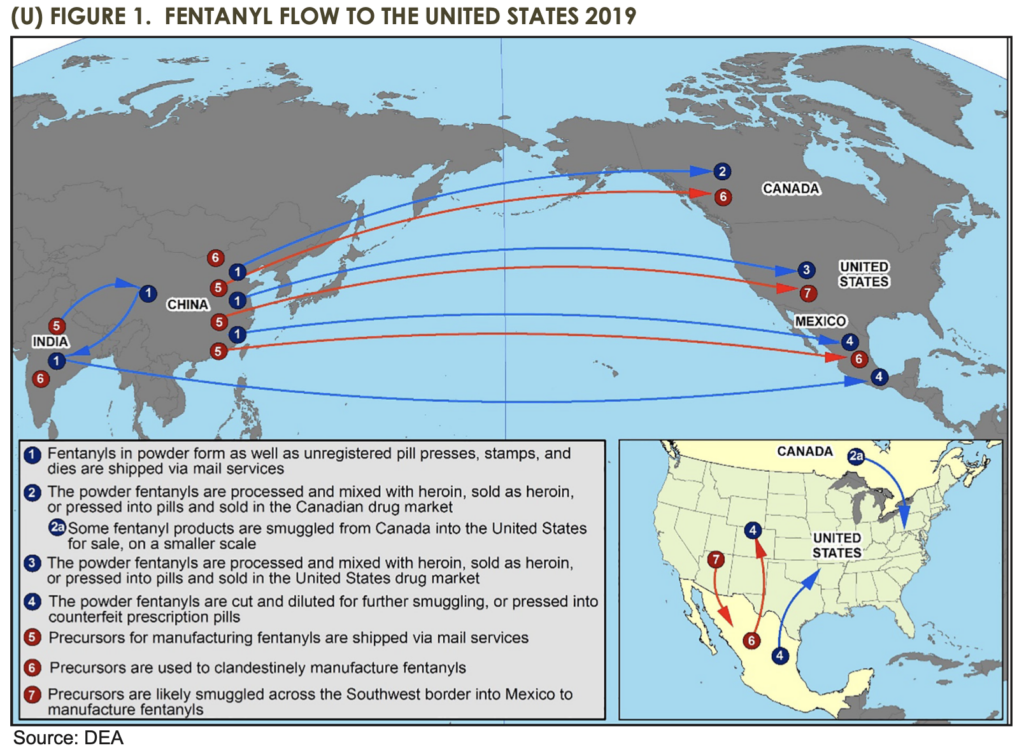
China’s regulatory actions have been notable, with a comprehensive control measure implemented in May 2019, fulfilling a commitment made during the G-20 Summit. This measure includes stringent investigations of manufacturing areas, tighter control over online advertising, enhanced shipping regulations, and the formation of specialized teams to combat trafficking. These measures were anticipated to have a significant impact on reducing fentanyl production and trafficking from China, potentially altering its role as a major supplier to both the US and Mexico.
Meanwhile, Mexican TCOs have been ramping up their production of fentanyl and illicit fentanyl-containing tablets, utilizing increasingly sophisticated clandestine laboratories and processing methods. Collaboration between the DEA and Mexican authorities has led to the dismantling of numerous operations involved in fentanyl pill pressing and synthesis. The Sinaloa and New Generation Jalisco cartels have been identified as primary traffickers of fentanyl into the US from Mexico, with operations often located in territories under their control.
A noteworthy development is the nexus between Indian suppliers and Mexican TCOs. An illicit fentanyl laboratory was dismantled in India in 2018, following information provided by the DEA. Indian nationals, in collaboration with Chinese counterparts associated with the Sinaloa Cartel, were involved in the production and trafficking of fentanyl precursor chemicals. Shifts in production from China to India were observed, likely due to China’s regulatory crackdown and difficulties in obtaining precursor chemicals. Seizures of fentanyl precursor chemicals in India linked to Mexico underscore the growing ties between Indian suppliers and Mexican TCOs.
The fentanyl flow: illegal migrants or legal citizens
The scourge of fentanyl overdoses has left a trail of tragedy, claiming tens of thousands of lives needlessly lost each year. In the midst of this crisis, a narrative has emerged placing the blame squarely on unauthorized migrants crossing the US border illegally. However, a closer examination of the facts reveals a starkly different reality.
According to a recent NPR-Ipsos poll, a significant portion of Americans, especially Republicans, believe that most fentanyl entering the US is smuggled in by unauthorized migrants. This perception, however, does not align with the data. Contrary to popular belief, fentanyl smuggling is overwhelmingly driven by US citizens for US citizen consumers.
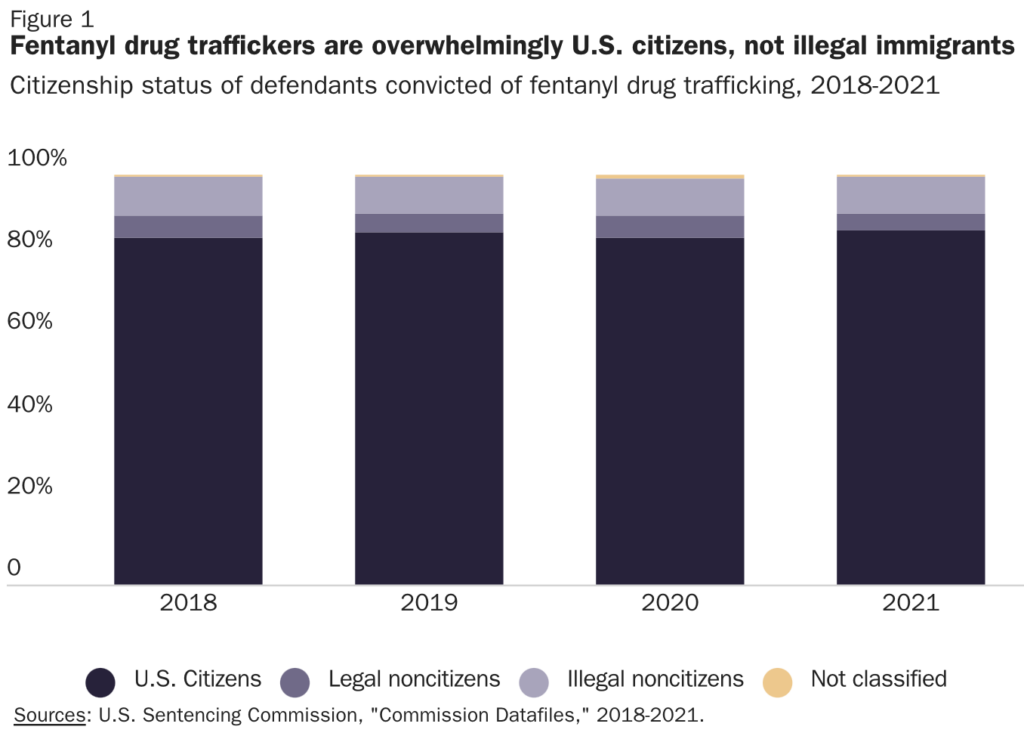
Fentanyl trafficking is intricately linked to domestic demand for illicit opioids, with nearly 99 percent of consumers being U.S. citizens. The majority of convictions for fentanyl drug trafficking involve US citizens, comprising 86.3 percent of convictions in 2021, compared to just 8.9 percent for illegal immigrants.
Analysis of fentanyl border seizures further supports this conclusion, revealing that over 90 percent occur at legal crossing points or interior vehicle checkpoints, predominantly involving US citizens. The strategic choice of smuggling locations underscores the ease with which fentanyl can be transported through legal channels, highlighting the inefficacy of border enforcement in curbing its influx.
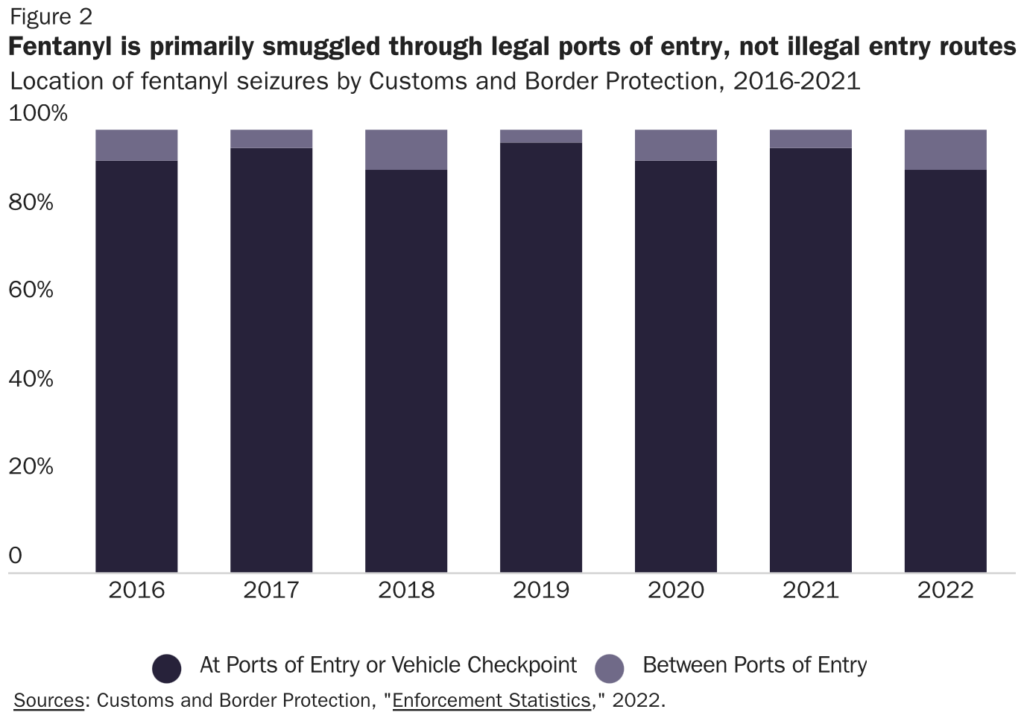
The ramifications of government policies, such as travel restrictions implemented during the pandemic, have exacerbated the crisis. Restrictions on legal cross-border traffic inadvertently led to a surge in fentanyl seizures, as traffickers adapted their tactics to exploit vulnerabilities in border security.
The shift towards fentanyl smuggling has been driven by its potency and profitability, with traffickers capitalizing on its compact form and high demand. This transition has contributed to a staggering increase in fentanyl-related deaths, nearly doubling between 2019 and 2021.
Fundamentally, the fentanyl epidemic is a consequence of prohibitionist policies that perpetuate the underground drug trade. The “iron law of prohibition” dictates that stringent restrictions on drugs lead to the proliferation of more potent and dangerous substances like fentanyl.
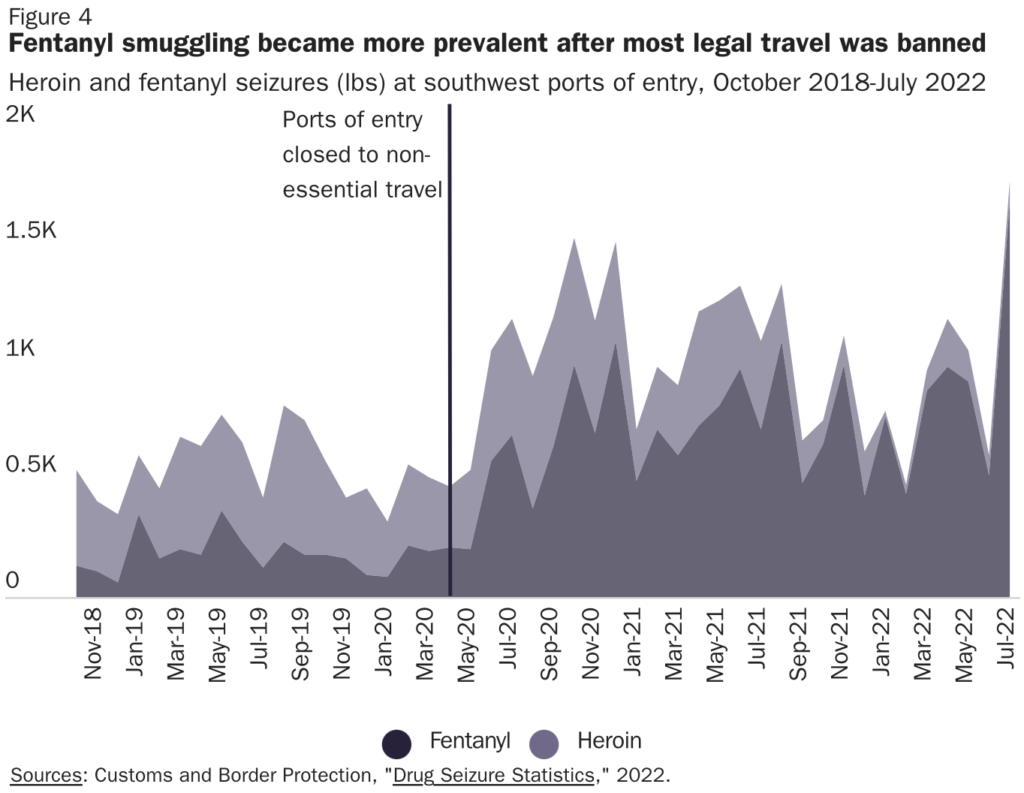
The fentanyl flow: silent killer
According to experts, fentanyl, which is up to 50 times stronger than heroin and 100 times stronger than morphine, remains a leading cause of fatal and nonfatal overdoses in the US. The statistics are alarming, with over 150 people succumbing to overdoses related to synthetic opioids like fentanyl each day.
The COVID-19 pandemic has further exacerbated the crisis, disrupting supply chains and leading individuals to experiment with unfamiliar drugs. Social-distancing measures have also contributed to the problem, as more people are consuming drugs alone, increasing the likelihood of overdosing.
A concerning trend highlighted by recent research is the surge in fentanyl-related deaths among youths, particularly those between the ages of ten and nineteen. Fatal overdoses in this demographic nearly doubled from 2019 to 2021, partly fueled by the ease of purchasing counterfeit pills through social media platforms.
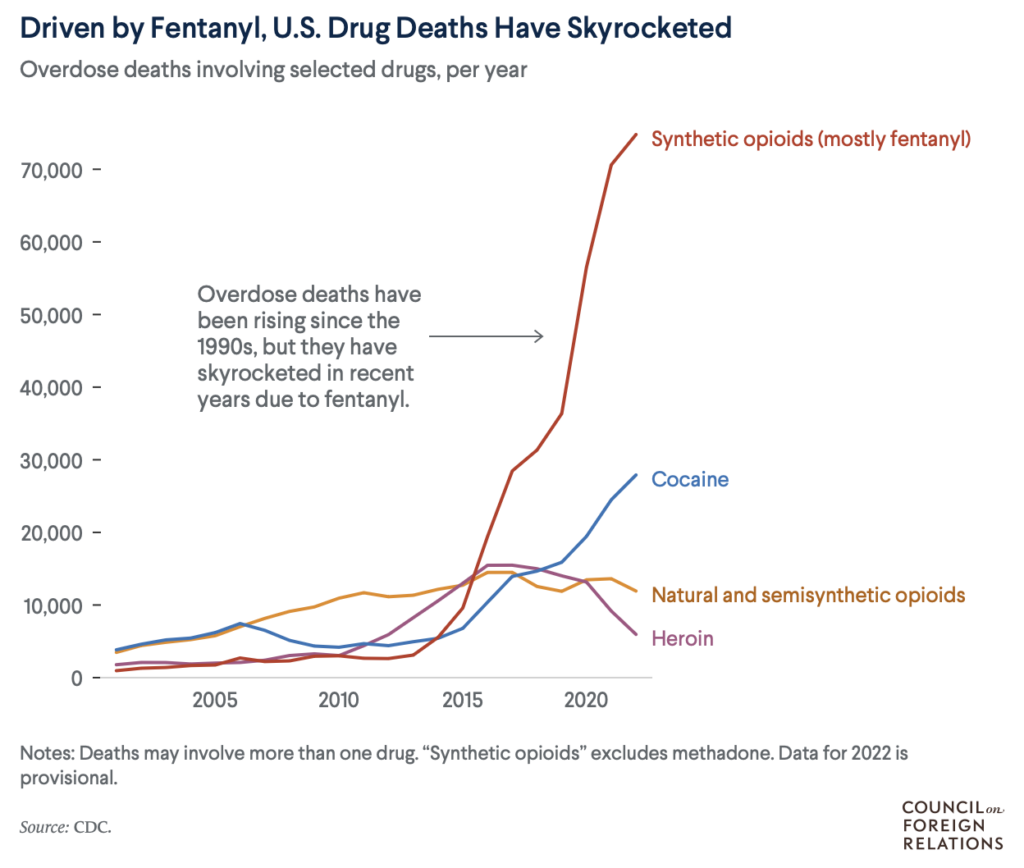
Moreover, fentanyl’s deadly toll transcends demographic boundaries, impacting various segments of the population. Data shows that American Indian and Alaska Native people, Black individuals, younger adults, and men are disproportionately affected by fentanyl-linked overdoses. Other groups, including military veterans, people with disabilities, and those without health insurance, have also borne the brunt of the opioid epidemic.
The economic ramifications of the crisis are equally staggering. Reports suggest that the opioid epidemic cost the US nearly $1.5 trillion in 2020, equal to approximately 7 percent of the gross domestic product. This figure, projected to rise given the increase in fatal overdoses, encompasses healthcare expenses, law enforcement efforts, lost productivity, and the immeasurable costs of human lives lost to overdose.
The availability of illicit fentanyl, often disguised as legitimate prescription opioids by drug cartels, has compounded the problem. In 2022, the DEA seized a record number of fentanyl-laced fake prescription pills, highlighting the scale of the challenge faced by law enforcement agencies.
Researchers warn that fentanyl’s extreme potency not only heightens its addictive potential but also makes it more lethal, perpetuating the crisis. A lethal dose of the drug, equivalent to just two milligrams, underscores the urgent need for comprehensive interventions to address its proliferation.

The fentanyl flow: Canada
The problem isn’t exclusive to the US and Mexico. Recent data paints a sobering picture of Canada’s ongoing battle with the opioid crisis, showcasing that the country has been grappling with a dire surge in opioid-related deaths and associated harms since surveillance efforts commenced in 2016 under the purview of the Public Health Agency of Canada.
Recent data spanning from January 2016 to June 2023 provides a stark snapshot of the crisis’s toll across the country. Despite ongoing collaborative efforts with federal, provincial, and territorial partners to comprehend the full spectrum of harms and substances involved, the gravity of the situation remains distressingly clear.
According to the most recent available figures, a staggering 40,642 apparent opioid toxicity deaths occurred between January 2016 and June 2023. In the first half of 2023 alone, there were 3,970 such deaths, averaging 22 fatalities per day. Alarmingly, this represents a 5% increase compared to the same period in 2022, underscoring the persistent escalation of the crisis.
The bulk of these tragic outcomes have been concentrated in British Columbia, Alberta, and Ontario, although elevated mortality rates have been observed in regions with smaller populations as well. Furthermore, the demographics of those affected paint a distressing picture, with young- to middle-aged males comprising the majority of accidental opioid toxicity deaths.
Earlier this year, the province of British Columbia expanded the distribution of “safer supply” fentanyl to minors without parental consent. The controversial decision, outlined in protocols published by the British Columbia Centre on Substance Use (BCCSU), has sparked criticism from experts and raises ethical questions surrounding the issue of informed consent for underage individuals.
One of the primary drivers of this crisis is the toxicity of the drug supply, with fentanyl playing a particularly lethal role. A staggering 84% of accidental opioid toxicity deaths in the first half of 2023 involved fentanyl, representing a 47% increase since surveillance began. Additionally, a concerning 80% of these deaths involved non-pharmaceutical opioids, underlining the prevalence of illicit substances in the crisis.
Multi-drug toxicity further compounds the severity of the situation. Data from eight provinces and territories revealed that almost all apparent stimulant toxicity deaths in the first half of 2023 were accidental. Moreover, over half of accidental opioid toxicity deaths during this period also involved stimulants, with opioids, cocaine, and methamphetamines frequently co-occurring.
Hospitalization rates due to opioid and stimulant poisonings further illuminate the crisis’s breadth. Between January 2016 and June 2023, there were 39,435 opioid-related and 16,863 stimulant-related poisoning hospitalizations in Canada, excluding Quebec. Notably, the number of opioid-related poisoning hospitalizations in the first half of 2023 was 11% higher than the same period in the previous year, emphasizing the persistent strain on healthcare resources.
Once again, Ontario, British Columbia, and Alberta bore the brunt of these hospitalizations, with males representing a disproportionate share of cases across varying age groups. The involvement of fentanyl and its analogues in a significant proportion of these hospitalizations underscores the lethal nature of the current drug supply.
Emergency Medical Services (EMS) responses further highlight the urgency of the situation. With over 20,000 responses to suspected opioid-related overdoses in the first half of 2023, it’s evident that the crisis continues to exact a heavy toll. As with other metrics, young- to middle-aged males remain disproportionately affected, constituting the majority of EMS responses.
The fentanyl flow: stoppage
Despite longstanding efforts, including substantial aid to Mexico through initiatives like the Mérida Initiative, the influx of illicit narcotics, particularly fentanyl, has continued to pose a significant threat to public health and safety.
In response to the escalating crisis, US President Joe Biden declared synthetic-opioid trafficking a national emergency in late 2021. Subsequently, he signed executive orders enabling the administration to sanction individuals and entities involved in the production and dissemination of fentanyl. Notably, the US government imposed sanctions on twenty-five China-based firms and individuals believed to be connected to the production of fentanyl precursor chemicals.
Moreover, recognizing the global nature of the fentanyl trade, Biden has sought increased cooperation from key partners such as China and Mexico. In November 2023, bilateral agreements were reached with Chinese President Xi Jinping and Mexican President Andrés Manuel López Obrador to enhance collaboration in preventing the manufacturing and distribution of illicit fentanyl.
Simultaneously, efforts to address the crisis domestically have been intensified. Federal regulators have implemented stricter limits on opioid prescriptions and ramped up efforts to seize fentanyl. Additionally, public awareness campaigns have been launched to educate the public about the dangers of fentanyl, particularly its prevalence in counterfeit prescription drugs.
A significant development in combating fentanyl overdoses came with the approval of Narcan, a naloxone nasal spray, for over-the-counter sale by the Food and Drug Administration in March 2023. This marked a crucial advancement in overdose prevention efforts, although challenges remain regarding accessibility and affordability.
Furthermore, alternative approaches have been proposed by experts to address the multifaceted nature of the crisis. Suggestions include increased research and development, the establishment of supervised consumption sites, and enhanced border inspections to intercept illicit narcotics.
In a recent move, the Massachusetts state Senate unanimously voted to legalize fentanyl test strips across the commonwealth. These strips, which were previously considered illegal drug paraphernalia, are now recognized as a vital tool in harm reduction efforts. Sarah Wakeman, the senior medical director for Substance Use Disorder at Mass General Brigham, highlighted the significance of these strips in detecting the presence of fentanyl in illicit drugs, thereby reducing the risk of overdose.
Wakeman explained, “A test consists of a little white rectangle that you dip into a liquid substance that contains a drug, and it will test for whether fentanyl is present or not.” She emphasized the importance of these strips in an era of contaminated drug supply, where illicit drugs are often laced with fentanyl, posing a grave risk to individuals.
The legalization of fentanyl test strips reflects a broader shift towards harm reduction strategies in addressing the fentanyl crisis. With nearly 40 states now permitting their use, these strips represent a crucial tool in safeguarding public health amidst the ongoing epidemic.
Robert Steen, CEO and Chairman of PharmaDrug Inc. (CSE: PHRX), has also underscored the importance of “a multi-dimensional approach” in addressing the issue, instead of restrictive drug control.
“I spent a large part of my career building and operating multiple substance abuse clinics. One of the gravest issues today with substance abuse is fentanyl contamination,” Steen remarked. “I want to be crystal clear that I or PharmaDrug do not condone the abuse of drugs and that we believe that rehabilitation should continue to be the main focus. However, drug abuse is a complex issue that requires a multi-dimensional approach.”
For their part, the firm advocates for producing safe supplies through domestically regulated biosynthetic versions of substances. They anticipate benefits such as verified manufacturing processes, pharmaceutical-grade quality, and legally sourced inputs, eliminating reliance on illegal international sources.
“A significant portion of street drugs are contaminated with lethal substances like fentanyl and the supply chain cannot be controlled. Harm reduction for abusers should also be addressed,” he added.
His comments came as PharmaDrug announced in December 2023 its plans for the recently acquired private pharmaceutical research and development company SecureDose, which focuses on the development of synthetic formulations of currently existing drugs for potential commercialization and distribution. Research is said to be already underway with a third party regulated university lab for such formulations, with further details to be released in the coming months.
Information for this briefing was found via BBC, AlJazeera, The Harvard Gazette, and the sources mentioned. The author has no securities or affiliations related to this organization. Not a recommendation to buy or sell. Always do additional research and consult a professional before purchasing a security. The author holds no licenses.
FULL DISCLOSURE: PharmaDrug is a client of Canacom Group, the parent company of The Deep Dive. Canacom Group is currently long the equity of PharmaDrug. The author has been compensated to cover PharmaDrug on The Deep Dive, with The Deep Dive having full editorial control. Not a recommendation to buy or sell. Always do additional research and consult a professional before purchasing a security.

